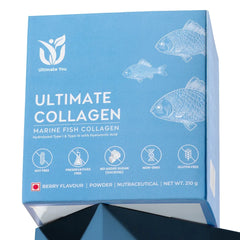Hair loss is a major concern that affects millions of people globally. Whether it's a receding hairline, thinning crown, or shedding strands, the root of the problem often points to a hormone called DHT. You might have heard of it in hair loss discussions, but —
What is DHT really?
And how exactly does DHHT impact your hair growth?
Let's dive deep into the science and uncover the truth behind this powerful hormone.
What is DHT?
DHT stands for Dihydrotestosterone, an androgen hormone derived from testosterone. It's known for playing a crucial role in the development of male characteristics like body hair, muscle mass, and a deep voice. DHT is created when the enzyme 5-alpha-reductase converts testosterone into this more potent form. While DHT is present in both men and women, its effects are typically more pronounced in men due to higher levels of testosterone.
Dihydrotestosterone (DHT) is synthesized primarily in the adrenal glands, prostate, testes, and hair follicles. Around 10% of the testosterone in an adult male gets converted into DHT daily, which then travels through the bloodstream to interact with androgen receptors in different tissues.
How is DHT produced in the body?
The conversion of testosterone to DHT occurs through the enzyme 5-alpha-reductase. There are two types of this enzyme: Type I and Type II. Type II is most commonly found in hair follicles and the prostate, making it a significant factor in hair loss and prostate health.
DHT and Male Sexual Development
DHT is essential during foetal development and puberty. It aids in the formation of male genitalia in the womb and supports puberty-related changes like:
- Deepening of the voice
- Growth of facial and body hair
- Increased muscle mass
- Enlargement of the prostate and penis
DHT and Other Bodily Functions
Even after puberty, DHT continues to play important roles:
- Supports libido and sexual function
- Contributes to cognitive and emotional well-being
- Regulates fat distribution and muscle strength
DHT and Hair Loss – What's the Connection?
How DHT Affects Hair Follicles
Hair follicles have androgen receptors that DHT can bind to. When DHT binds to these receptors in scalp hair follicles, it triggers a process called "miniaturization."
DHT and Follicle Miniaturization
Miniaturization refers to the shrinking of hair follicles. This leads to:
- Thinner and shorter hair
- A shortened anagen (growth) phase
- Premature entry into the telogen (resting) phase Over time, these follicles may stop producing hair altogether.
Hair Growth Cycle Disruption
Normally, hair follows a cycle of growth (anagen), transition (catagen), and rest (telogen). DHT shortens the growth phase and prolongs the resting phase, reducing the overall hair density.
Genetic Sensitivity to DHT
Androgenetic Alopecia Explained
Also known as male-pattern baldness or female-pattern hair loss, androgenetic alopecia is a genetic condition where hair follicles are sensitive to DHT. This sensitivity causes progressive thinning and balding, especially in genetically predisposed individuals.
Why Some People Are More Affected
Not everyone loses hair due to DHT. The key lies in genetic sensitivity. If your hair follicles are genetically programmed to be sensitive to DHT, even normal levels can trigger hair loss.
DHT in Men vs Women
Male Pattern Baldness
In men, DHT-related hair loss typically begins at the temples and crown, forming an "M" shape. Over time, these areas may join, leading to partial or complete baldness.
Female Pattern Hair Loss
Women usually experience diffuse thinning across the scalp rather than receding hairlines. DHT can still play a role, especially in post-menopausal women when estrogen levels drop.
Benefits of DHT for Hair
While DHT often gets a bad rap for causing hair loss, it actually plays some beneficial roles too, especially outside the scalp.
Helps Develop Body and Facial Hair
During puberty, DHT stimulates the growth of:
- Beard
- Chest and armpit hair
- Pubic hair This is why boys suddenly sprout facial and body hair during adolescence.
Improves Hair Thickness in Non-Scalp Areas
Interestingly, DHT can enhance the thickness and pigmentation of body hair. It stimulates the growth of hair in areas like the chest, back, and face.
Supports Hormonal Balance
A healthy DHT level is crucial for maintaining androgen balance, which supports:
- Mood stability
- Libido
- Muscle mass
Foods That May Lower DHT Naturally
If you're struggling with hair thinning or pattern hair loss, chances are you've come across the hormone DHT (Dihydrotestosterone) as a possible culprit. While DHT plays essential roles in the body, excess amounts or increased sensitivity to it can trigger hair loss—especially if you’re genetically predisposed. The good news?
Certain foods can naturally support hormonal balance and protect your hair. Let’s explore five powerful ingredients that may help reduce the impact of DHT and promote stronger, healthier hair.
1. Green Tea
If you enjoy sipping green tea, you’re also doing your hair a favor. Green tea contains a plant compound called EGCG (Epigallocatechin Gallate), known for its antioxidant and anti-inflammatory properties. What makes EGCG especially interesting for hair health is its ability to interfere with the enzyme that turns testosterone into DHT. In simpler terms, it helps reduce DHT levels right at the source.
Beyond blocking DHT, EGCG also promotes better blood circulation to your scalp. That means your hair follicles receive more oxygen and nutrients, helping them stay active longer and grow stronger strands.
2. Pumpkin Seeds
Pumpkin seeds are a rich, plant-based source of zinc—a mineral your body needs to maintain balanced hormone levels, including those related to hair loss. Zinc helps regulate oil production on the scalp, supports healthy follicle function, and plays a role in preventing the excess formation of DHT.
What gives pumpkin seeds an added edge is their content of phytosterols—plant compounds that may naturally slow the activity of DHT. Incorporating these crunchy seeds into your diet not only benefits your hair but also supports immune health and skin quality.
3. Soy Products
Soy-based foods such as tofu, soy milk, and edamame are rich in isoflavones—particularly genistein—which can mimic the effects of estrogen in the body. This can help maintain hormonal equilibrium, especially in cases where androgen levels like DHT are tipping the balance.
For those dealing with hormonally driven hair thinning, particularly women post-menopause, soy isoflavones may offer a gentle way to support hair density while also adding high-quality plant protein, essential for building the keratin that makes up your hair.
4. Flaxseeds
Flaxseeds are one of the best sources of alpha-linolenic acid (ALA)—a type of omega-3 fatty acid that helps reduce inflammation throughout the body, including the scalp. Chronic inflammation is often an overlooked factor in hair loss, as it weakens follicles and disrupts the natural hair cycle.
Flaxseeds also contain lignans, which may help in balancing hormones and minimizing the negative impact of androgens like DHT. Just a spoonful a day can nourish your scalp, keep hair follicles calm, and support thicker regrowth.
5. Berries
Berries—like blueberries, strawberries, and raspberries—are packed with vitamin C, an antioxidant that protects hair follicles from oxidative stress. Oxidative stress can damage the scalp environment and make it easier for DHT to interfere with the growth cycle.
Vitamin C also boosts collagen production, a protein that supports the scalp’s structure and strengthens hair from the root. Bonus? It improves iron absorption, another vital mineral linked to preventing hair thinning, especially in women.
Apart from the above mentioned foods, you can also make use of spirulina and amla. Spirulina, rich in protein, iron, and B vitamins, is essential for hair strength. It also contains antioxidants that reduce scalp inflammation. Amla (Indian gooseberry) is high in vitamin C and polyphenols, which combat oxidative stress, boost collagen, and inhibit DHT activity.
DHT-Blocking Treatments and Medications
Topical and Oral DHT Blockers
Finasteride: A prescription oral medication that inhibits Type II 5-alpha-reductase. Effective but may have side effects.
Minoxidil: A topical treatment that helps extend the hair growth phase. Doesn't block DHT directly but supports follicle health.
Nutrients That Support Hair Health
-
Biotin: Promotes hair strength and growth.
-
Zinc: Essential for enzyme function, including hormone regulation.
-
Vitamin D: Linked to hair follicle cycling.
-
Iron: Prevents hair thinning caused by deficiency.
Conclusion
DHT plays a complex role in the body. While it contributes to hair loss in sensitive individuals, it also supports many vital functions. Understanding its impact and managing it smartly can help you maintain healthier hair without disrupting your hormonal health. Whether through lifestyle changes, natural supplements, or medical interventions, there are multiple paths to addressing DHT-related hair issues effectively.
Disclaimer
The information provided is for educational purposes only and is not intended to be a substitute for medical treatment. If you're pregnant, nursing, taking medication, or have a medical condition, it's better to consult a healthcare professional. Ultimate You does not provide any guarantee regarding the accuracy, adequacy, completeness, legality, reliability, or usefulness of the information and disclaims any liability arising from it.









